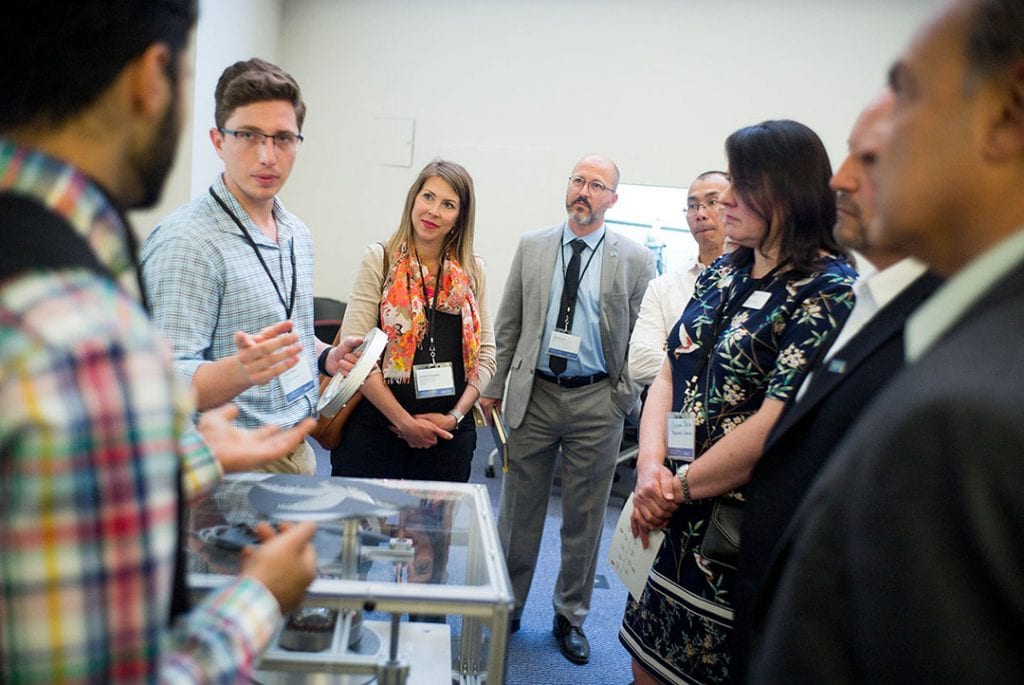
Academic leaders and industry partners talk with members of SJSU’s Spartan Hyperloop team at the Innovation Design Collaborative at San Jose State on Friday, June, 8, 2018. (James Tensuan/San Jose State University)
By David Goll
Visionaries view a futuristic tube containing capsules, or “pods,” speeding passengers more than 700 miles per hour between the Bay Area and Los Angeles in about a half hour as one way to help ease the Golden State’s congested roadways.
And engineers of the future studying today at San Jose State University want to play a big part in moving what is called “hyperloop” technology from design and testing phases into reality. They are looking for solutions for one of the world’s busiest travel corridors in the nation’s most-populous state, boasting the world’s fifth-largest economy.
“In general, there has been a lack of innovation in the transportation sector,” said Ali-Imran Tayeb, who earned bachelor’s degrees in Mechanical Engineering and Physics in December from SJSU. “The cars, planes and boats keep getting better, but we haven’t seen new forms of transportation systems. We learned a lot from the (2018 Hyperloop Pod) competition. There’s such a strong need for this type of travel.”
Tayeb co-founded the Spartan Hyperloop project three years ago and leads its Mechanical team. In July, he was among a team of 20 SJSU undergraduates and recent graduates who took their Spartan Hyperloop magnetic levitation creation to participate in the 2018 Hyperloop Pod competition sponsored by Space Exploration Technologies Corp., better known as SpaceX. Headquartered in the Los Angeles suburb of Hawthorne, SpaceX is most known for its space-exploration technology and rocket launches. It was founded and is led by Elon Musk, also the high-profile CEO and co-founder of the Fremont-based upscale electric car manufacturer, Tesla Inc.
This version of Spartan Hyperloop — a 6-1/2-foot long, 2-1/2-foot wide, 2-foot high, 320-pound creation composed of an aluminum frame, battery packs and high-speed spinning magnets among other elements — was built to half the scale of the SUV-sized vehicle envisioned to transport passengers and cargo. Design of the SJSU project beat out 100 other entries from universities worldwide, making SJSU one of only two teams to qualify for the SpaceX competition in the levitation category. Unfortunately, a technical failure on the road disqualified the team from competing against the other qualifying team, University of California, Santa Barbara.
Thomas Baker, an SJSU senior majoring in Electrical Engineering who heads up the Spartan Hyperloop Electrical team, said mechanical problems affected the prototype, but work will continue to perfect Spartan Hyperloop.
Baker said a perfected Spartan Hyperloop design would operate by taking advantage of the low-friction environment of the tube to generate enough speed to cause levitation.
He said the SJSU team has had up to 60 members. Funding for the project came mostly from the university and corporate sponsors, but $2,200 was also raised through a Crowdfunding campaign supported by University Advancement, Baker said.
“We’ve worked really hard to get students from all of the STEM (Science, Technology, Engineering, Math) disciplines involved, as well as business and marketing,” Baker said.
SJSU has participated in all three years of the SpaceX competition, he said, having previously been a runner-up in design, before building Spartan Hyperloop this year.
Musk’s initial Hyperloop concept, introduced in 2012, included reduced-pressure tubes providing pathways for pressured capsules propelled by linear induction motors and axial compressors riding on air bearings. A proposed 350-mile route connecting California’s two-largest population and business centers would roughly parallel Interstate 5 through the Central Valley. Another of Musk’s companies, The Boring Co., has also proposed smaller-scale projects in Los Angeles, Chicago, the Baltimore/Washington D.C. area, with a possible extension to New York.
One study put the cost of building the Bay Area-to-Los Angeles Hyperloop connection at $6 billion for a passengers-only option and $7.5 billion for a larger tube that would carry both people and vehicles. Plans to build a high-speed rail line, already under construction in the San Joaquin Valley, are now estimated to cost $77 billion to connect the Bay Area to Los Angeles, and up to $98 billion to complete the full 800-mile system.
Baker considers the Hyperloop system – still on the drawing boards — a better deal.
“I have reservations about high-speed rail, which is using older technology and requires lots of infrastructure costs,” he said, noting contrasts in cost and environmental impacts. “We would be able to line (the tube) with solar panels and use the resulting energy for local communities along the line or give back to the grid.”